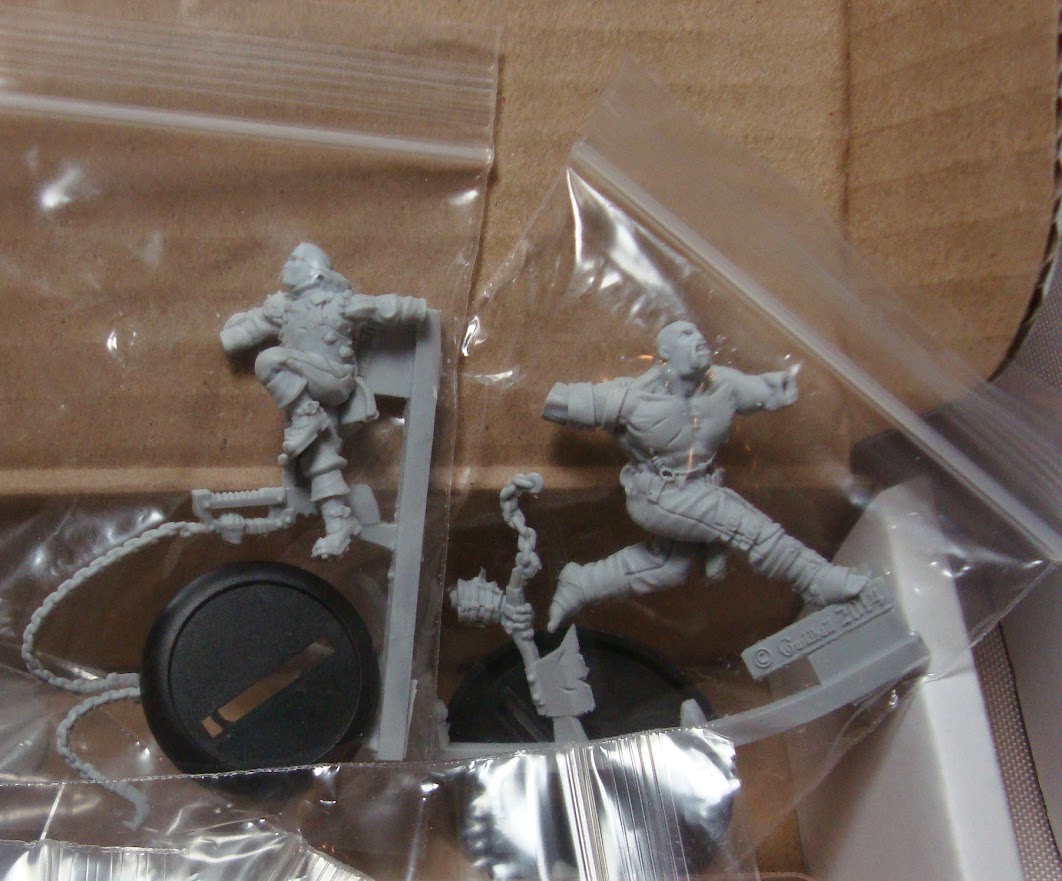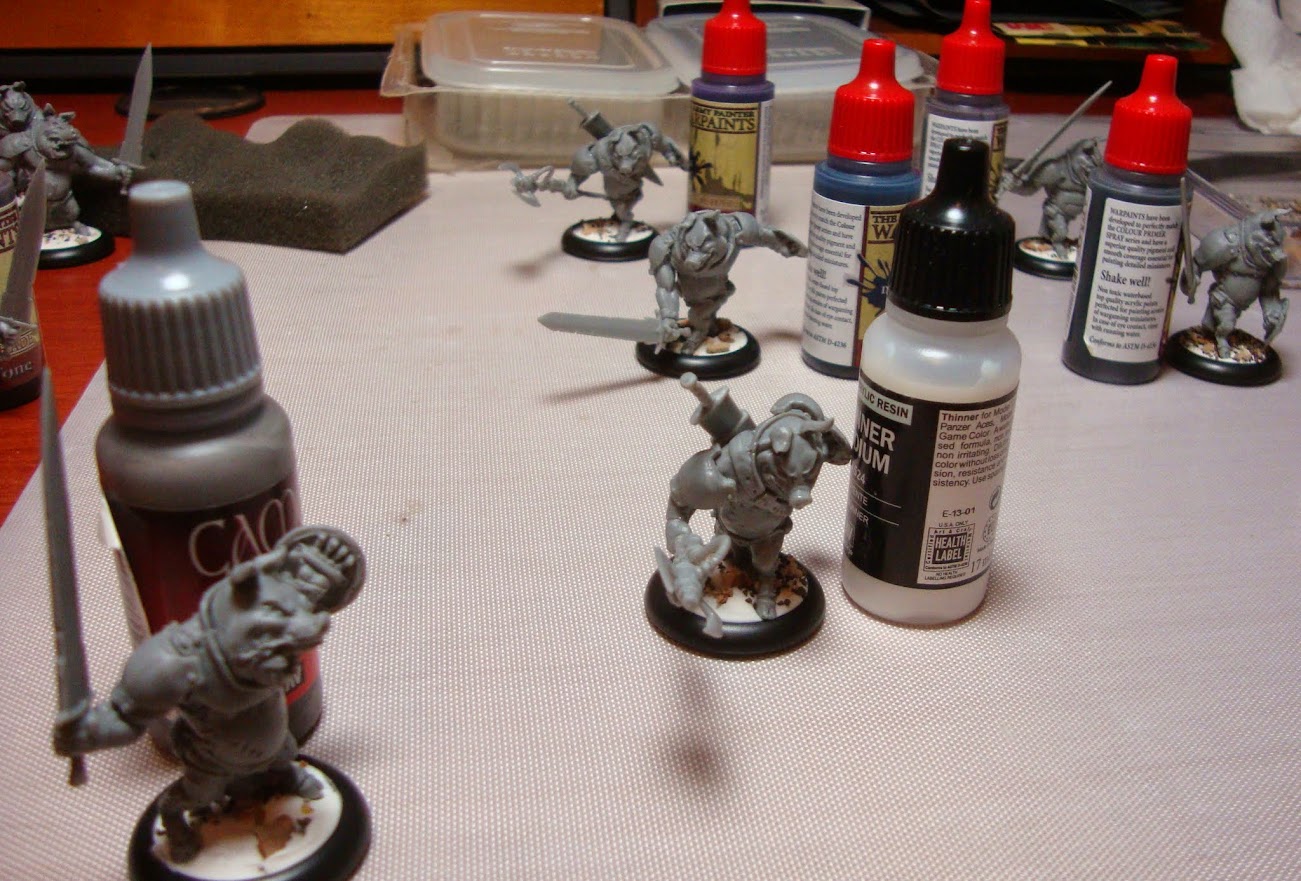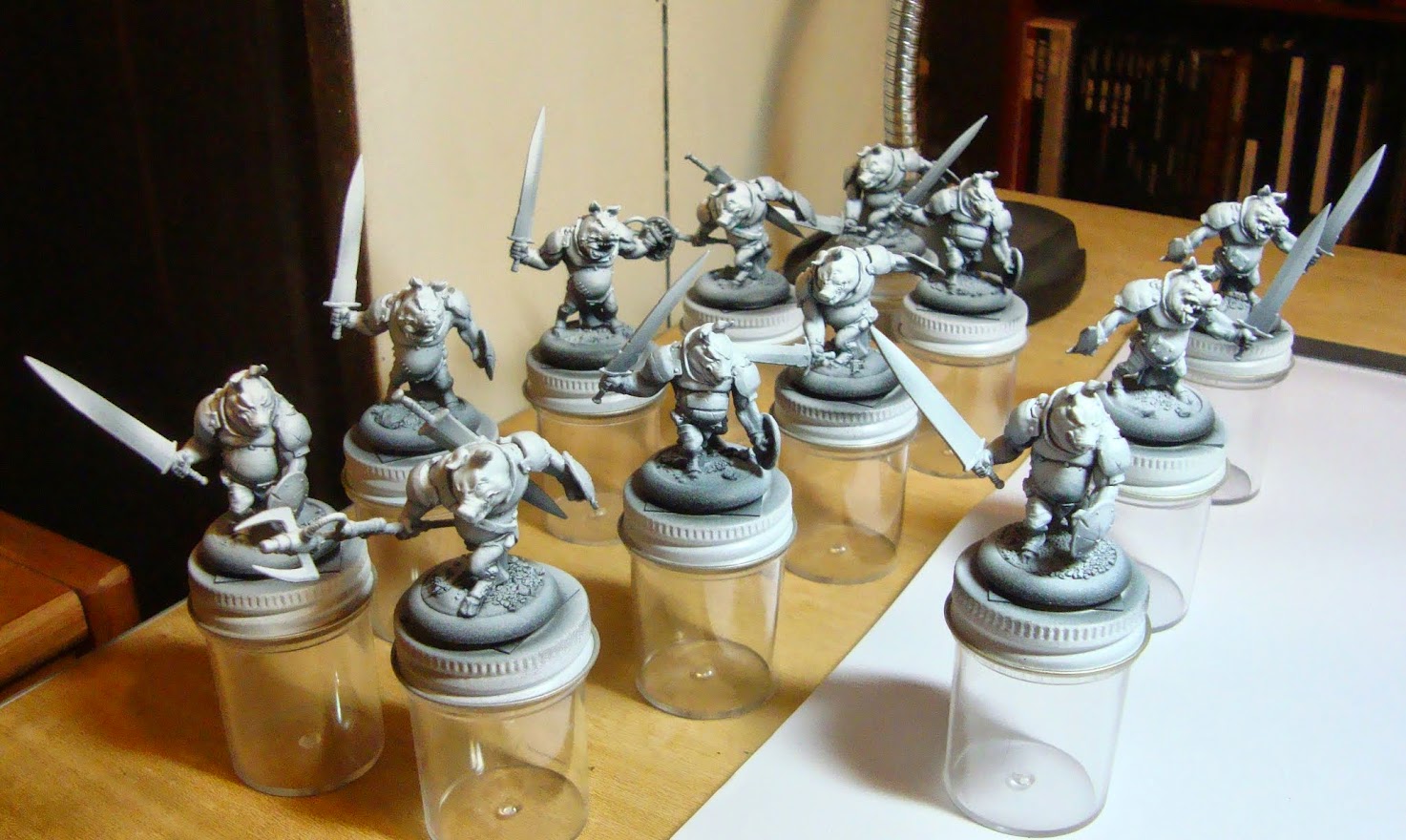The only problem is that it's only a month away, and I want to bring a fully painted, high tabletop-standard, starter set warband to play in the Wrath of Kings narrative campaign. Why's that a problem? The models are still in their starter box, untouched. I need to paint 30 models in one month....
I spent the last week prepping the first unit for the Teknes faction, the unit that first attracted me to the game, when the models were first introduced in resin, long before the game was released -- the Union Worker pigmen!
Here you see them propped up against paint-bottles, while they dry in their stand. More on that in a minute.
The plastic is PVC plastic, as opposed to the polystyrene plastic used for scale model kits. PVC plastic is a little more difficult to work with than polystyrene, but it's not horrible. You can use model cement, but it doesn't work as well as it does on polystyrene. It's a little frustrating, as the material is so close to behaving optimally, but it's just shy. These models were a little better-behaved than the Deadzone models, though.
For removing mold lines, I used an X-Acto blade and emery boards. The results for removing mold lines were good enough overall. There were some instances where I just couldn't scratch out a fine line -- for instance, along the spittle trail. That's a little grating, especially since the spittle trail is one of the coolest features for that particular sculpt, but the quality of the models overall makes up for it.
In addition to the smoothness of the plastic, one of the big benefits of the PVC is that all of the weapons were straight, without requiring a hot-water bath to straighten them out. Plus, the material holds excellent detail. And, as opposed to the fragile designs of Wyrd miniatures, these models are going to be robust game-pieces on the tabletop.
The design for the cuts is superb, and the mortise-and-tenon joints are shape-coded so that there are no mistakes. On the other hand, I think there was a mis-pack for one of the arms, and I had to cut it down, improvise the join, and fill the gaps with putty.
One odd feature for these designs, though, is the "deep-well" bases. I read that they're extra-deep, because they were intended for inserts that were available on the Kickstarter. I don't recall that add-on, and I apparently didn't buy them. Nor are they available otherwise, as far as I know. So that means most people are confronted with figuring out how to attach the models to the bases, without them looking like they're standing in a crater!
On top of that, the Union Workers have tiny little feet. So contact point is miniscule. They do have plastic pins, which helps a little, but there's not enough material to actually pin the model with paper clips. Nor would I want to for 30 models! It would have been nice to have had slottas and slotta-bases.
So my solution was to try out spackling compound.
This stuff had a nice pasty consistency that was easy to stir into the base. Faster and easier than Milliput. However, the spackle is not thick enough to hold the model upright, when you stick it in. Thus the dropper-bottle props.
The spackle is not adhesive enough to finish there, though. When it cured, the model pretty much just popped out.
So that required a follow-up session with 2-part, 5-minute epoxy.
The spackle is still soft, when it cures. Here you can see how easy it is to gouge out chunks of it with a wooden toothpick.
I'm thinking the Milliput might have been a better option after all, especially since you can texture the Milliput.
If I still want to use paste, Liquitex modeling paste would probably cure harder than the spackle.
I'll try some of these other options on the remaining models. 18 to go!
In other news, I acquired an overhead webcam to use with my Google Hangouts. This is the Ipevo VZ-1 HD.
It's pretty cool, because it does show a sharp image, where you can finally see the colors of the models, without them being washed out by the light. I still need to figure out how to set the focus, though. The auto-focus is actually too responsive, and it's constantly going in and out of focus, as I work on the model, even when I keep it in roughly the same position.
Another acquisition I'm excited about is the arrival of my Guildball Kickstarter. Yay! Finally!
These models are absolutely beautiful. It pays to jump in early in the production run, while the molds are still fresh!
 |
| The Fishermen's Guild |
 |
| The Butcher's Guild |
Here are the Union Workers with their coats of primer, using the zenithal technique.
For the next step, I finally pulled out my Grex airbrushes.
I won these airbrushes, when I won Best of Show at the very first Capital Palette competition in 2012 (before I volunteered to organize the event). I've been waiting to improve my airbrushing skill before using them. I may have waited too long, though. I now have no desire to use the airbrush on the right, since it's a side-feeder. The huge reservoirs and higher air pressure are intended for larger projects. Maybe I'll use it for terrain.
Both brushes have screw-on attach-points for the hose. They also have adapters for friction-fits. Unfortunately, I'm now spoiled, since I've been using a quick-release adapter (shown on the left in the picture below). I'll need to purchase an adapter for this brush to use the quick-release.











No comments:
Post a Comment
Note: Only a member of this blog may post a comment.